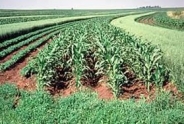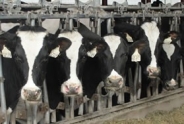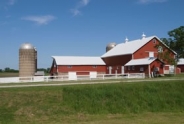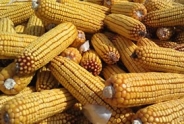Plan now for better 2023 weed control
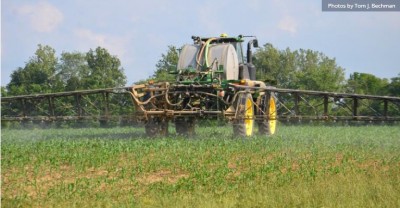
By Tom Bechman: American Agriculturist
Did you achieve the level of weed control you wanted in corn in 2022? Did you prevent weeds from growing with corn early in the season?
Bill Johnson, Purdue University Extension weed control specialist, says now is a good time to assess how well weed control worked. By evaluating this year's challenges and successes now, you can lay out an even better weed control strategy for 2023.
"A good weed control program in corn should revolve around two key principles," Johnson says. "First, recognize that corn doesn't like weed competition early in the season.
"Most people underestimate how much early-season weed pressure can impact corn growth and final yield. University research over the years documents that early weed competition in corn is usually more damaging to final yield than early weed competition in soybeans. Corn plants sense competition from other plants, including weeds, early, and it can affect growth patterns and plant decisions which impact yield."
The second key principle relates to the growth stage of corn. "After V6, and for sure at V7 and after, herbicide options in corn become limited," Johnson says. "Corn plants make crucial decisions about ear size and kernel set from those stages forward, and most herbicide labels cut off application around that point. You have much fewer options for herbicides if you haven't already controlled weeds."
ADVERTISING
Controlling weeds successfullyEach year, Johnson; Mark Loux, Extension weed control specialist at Ohio State University; and Aaron Hager, weed control specialist at the University of Illinois, discuss weed control issues and make joint recommendations. The result is the 2022 Weed Control Guide for Ohio, Indiana and Illinois.
The guide emphasizes two key steps for weed control in corn, Johnson says. "First, plan a broad-spectrum, residual weed control application," he says. "If you're in no-till, this would likely go on with the burndown application.
"The secret is to apply full labeled rates. With weeds like waterhemp in the mix, you can't afford to skimp on rates and risk not getting the best control possible."
The second step is a timely postemergence application. "Get weeds controlled early, ideally before they're 3 to 4 inches tall," Johnson says.
"Be sure you include more residual herbicide in that post application. Atrazine or an atrazine premix will work in many situations, depending on what you did before. There are other good choices too. Make the application while weeds are small."

These small weeds may look harmless, but weed control specialists insist even small weeds can impact corn yields more than most people think.
Judging weed sizeWould you know a 4-inch-tall weed if you saw one? Take a closer look at the picture below showing 2-inch, 3-inch and 4-inch weeds side by side. They were all pulled from the same location in the cornfield pictured here, with corn at the V4 to V5 stage.
Other weeds were also present. These three are all pigweed species, which includes redroot pigweed and waterhemp.

These three weeds of the pigweed species were pulled from the field pictured above. The tallest is roughly 4 inches. Purdue Extension weed control specialist Bill Johnson prefers taking out weeds as small as 2 inches in corn.
"You definitely want to spray waterhemp plants at 4 inches or less," Johnson says. "The truth is, you ought to be spraying them no matter which species they are by this point.
"Spraying when the biggest weeds are 2 to 3 inches tall in corn would be preferable. You don't want weeds to compete any longer than necessary with corn plants."
Learn to recognize and estimate weed height without the ruler or Coke can present, Johnson says. They're included in the picture to help give perspective and identify actual weed size.
"You can carry a tape measure if you want, but the point is to recognize what small weeds look like," he says. "Many people underestimate how big weeds truly are. You will have better success if you come back with a post pass with residuals in corn when weeds are smaller rather than larger."
Upcoming Events
Crops, Cows & Critters - Southwest New York Dairy, Livestock & Field Crops Newsletter Sponsorship
December 19, 2025
Our two forms of publications feature research-based and timely information from our four specialists, listed to the right, along with local event notifications and Cornell University outreach. This information is provided to participants who range from dairy, livestock, and field crops producers to agricultural suppliers and consultants.
Weekly Email Update: Shared with 625+ households who have signed up with our program.
Monthly Paper Mailer: To reach our stakeholders and farmers who lack internet access, we send out a monthly mailer where your company's logo and contact information would be featured with a mailing list of 330+ households.
If you sponsor our weekly and monthly publications you reach approximately 955 households.
Visit our website to view our newsletters!
2025 Cornell Food Beverage & Animal Feed Manufacturer Survey
December 19, 2025
Industry and Educational Advocates for New York State's Food, Beverage, and Animal Feed Manufacturing industries:
As you know, NYS has a diverse food and beverage manufacturing industry, in both the types of industries that exist and the wide distribution of firms by scale. Many manufacturing firms have strong backward linkages to agricultural production sectors in the state that support both farm-level and downstream food industry firms and consumers. In collaboration with the New York State Department of Agriculture and Markets, a team from Cornell University's Charles H. Dyson School of Applied Economics and Management has recently rolled out the 2025 New York State Food, Beverage, and Animal Feed Manufacturer Survey. The industry will benefit from an updated assessment of the industry that informs private and public investments and opportunities to support firm growth and improved profitability.
Cornell Organic Field Crops & Dairy Conference
March 6, 2026
Waterloo, NY
Farmers, researchers, educators, and agricultural service providers from across the Northeast are invited to the 2026 Cornell Organic Field Crops & Dairy Conference, held Friday, March 6, 2026, from 8:00 a.m. to 4:30 p.m. at the Lux Hotel & Conference Center in Waterloo, N.Y.
Co-hosted by New York Soil Health and Cornell CALS, the annual conference brings together leaders in organic grain, dairy, and livestock systems to share practical tools, new research, and farmer-tested strategies to support resilient and profitable organic production.
Announcements
No announcements at this time.

